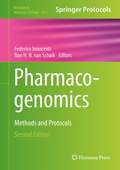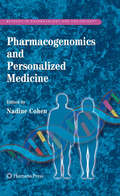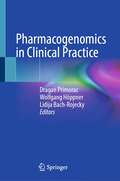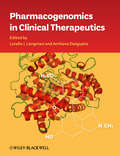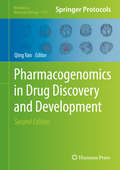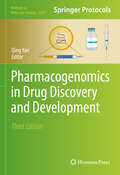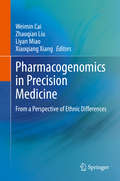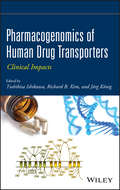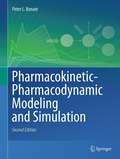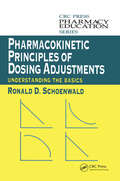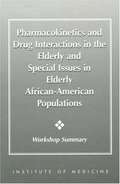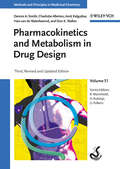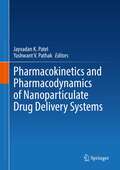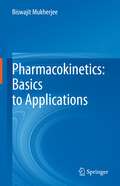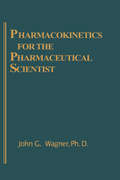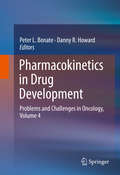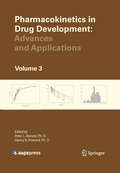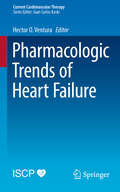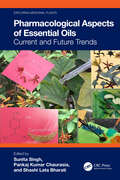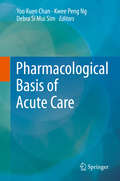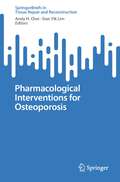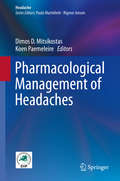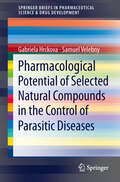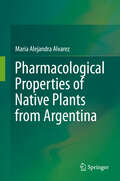- Table View
- List View
Pharmacogenomics: Methods and Protocols
by Federico Innocenti Ron H.N. SchaikUnderstanding an individual's genetic makeup is the key to creating personalized drugs with greater efficacy and safety, and pharmacogenomics aims to study the complex genetic basis of inter-patient variability in response to drug therapy. Based upon the success of its first edition, the second edition of Pharmacogenomics: Methods And Protocols aims to continue providing readers with high-quality content on the most innovative and commonly adopted technologies in the field of pharmacogenomics as presented by experts in the field. Broken into several sections, this detailed volume examines techniques for interrogating variation in human genes and genomes, functional assessment of genetic variation, both in vitro and in vivo, as well as tools for translation and implementation of pharmacogenetic markers. Written in the highly successful Methods in Molecular BiologyTM series format, chapters include introductions to the respective topics, lists of the necessary materials and reagents, step-by-step, readily reproducible laboratory protocols, and key tips on troubleshooting and avoiding known pitfalls. Comprehensive and thoroughly updated, Pharmacogenomics: Methods And Protocols, Second Edition serves as an essential reference and an invaluable source on the latest information in this field.
Pharmacogenomics and Personalized Medicine
by Nadine CohenWith all the multitude of challenges facing the pharmaceutical research and development process, the industry is actively exploring the relationships between human genetics and drug responsiveness, susceptibility to disease and disease severity. In Pharmacogenomics and Personalized Medicine, leading experts from the pharmaceutical industry, the scientific community and the government provide guidance for conducting pharmacogenomic research from discovery to the market, while also presenting a realistic perspective on the challenges, practicalities and obstacles in its application. Focusing on DNA data and associated analytical methodologies, with a consideration for complementary RNA-based studies, this volume includes a wide array of vital, cutting-edge research. Comprehensive and timely, Pharmacogenomics and Personalized Medicine will assist novice and experienced investigators alike in the understanding of the current scientific challenges in applying pharmacogenomics to drug discovery and clinical development.
Pharmacogenomics in Clinical Practice
by Dragan Primorac Wolfgang Höppner Lidija Bach-RojeckyThis book provides a practically applicable guide to the applications of pharmogenomics across medicine. Background information is provided on the mechanisms associated with membrane transporters, drug-metabolizing enzymes and their importance in pharmagenomics. Detailed guidance is subsequently presented on how to apply these techniques in disciplines including cardiology, gastroenterology, oncology, transplantation surgery, infectious diseases, anesthesia and analgesia, neurology, psychiatry, primary care, and public health. Clear easy-to-follow instructions are given on how to use big data technologies and public health databases in day-to-day clinical practice. Pharmacogenomics in Clinical Practice concisely covers how pharmacogenomic technologies and techniques can be applied in daily medical practice. It is therefore an ideal up-to-date resource for any medical practitioner, trainee or researcher across all medical disciplines who want to better understand how to use these techniques.
Pharmacogenomics in Clinical Therapeutics
by Loralie J. Langman Amitava DasguptaPharmacogenomics is the basis of personalized medicine which will be the medicine of the future. Through both reducing the numbers of adverse drug reactions and improving the use of existing drugs in targeted populations, pharmacogenomics represents a real advance on traditional therapeutic drug monitoring. Pharmacogenomics in Clinical Therapeutics provides an introduction to the principles of pharmacogenomics before addressing the pharmacogenomic aspects of key therapeutic areas such as warfarin therapy, cancer chemotherapy, therapy with immunosuppressants, antiretroviral therapy, and psychoactive drugs. It also includes methods of pharmacogenomic testing and the pharmacogenomic aspects of drug–drug interactions. From a team of expert contributors, Pharmacogenomics in Clinical Therapeutics is a comprehensive overview of the current state of pharmacogenomics in pharmacotherapy for all clinicians, pharmacologists and clinical laboratory professionals. It is also a guide for practicing clinicians and health care professionals to the basic principles of pharmacogenomics, laboratory tests currently available to aid clinicians, and the future promise of this developing field.
Pharmacogenomics in Clinical Therapeutics
by Loralie J. Langman Amitava DasguptaPharmacogenomics is the process of analyzing patients' genes to predict the onset of adverse reactions or forecast the effectiveness of therapeutic drugs. This useful text is written to discuss both the theory and the clinical application of the principles of pharmacogenomics. Current research has clearly established that a range of treatments may be greatly improved through genetic profiling of individual patients before certain therapies begin. Aimed at clinicians, pharmacologists, and clinical laboratory professionals this book discusses the important role of laboratory tests in the practice of personalized medicine. An important new book, Pharmacogenomics in Clinical Therapeutics serves as a guide to the basic principles of pharmacogenomics in a range of common therapeutic areas and as the basis of the personalized medicine of the future.
Pharmacogenomics in Drug Discovery and Development
by Qing YanThe field of pharmacogenomics arose to develop personalized medicine, or medicine that deals with the complexity of the human body. In this book, leading experts present methodical, state-of-the-art contributions covering topics from individual molecules to systemic diseases, examining both fundamental concepts and advanced technologies. The volume begins by exploring cutting-edge technologies used to pursue systems-based pharmacogenomics, followed by extensive chapters on gene-drug interactions and the use of pharmacogenomics in therapeutics of diseases. This book is ideal for scientists striving to transform disease treatment into disease prevention.
Pharmacogenomics in Drug Discovery and Development (Methods in Molecular Biology #2547)
by Qing YanThis new edition offers a state-of-the-art and integrative vision of pharmacogenomics by exploring new concepts and practical methodologies focusing on disease treatments, from cancers to cardiovascular and neurodegenerative disorders and more. The collection of these theoretical and experimental approaches facilitates problem-solving by tackling the complexity of personalized drug discovery and development. Written by leading experts in their fields for the highly successful Methods in Molecular Biology series, the book aims to provide across-the-board resources to support the translation of pharmacogenomics into better individualized health care. Authoritative and up-to-date, Pharmacogenomics in Drug Discovery and Development, Third Edition aims to aid researchers in approaching the challenges in pharmacogenomics and personalized medicine with the introduction of these novel ideas and cutting-edge methodologies.
Pharmacogenomics in Precision Medicine: From a Perspective of Ethnic Differences
by Weimin Cai Zhaoqian Liu Liyan Miao Xiaoqiang XiangThis book provides an introduction to the principles of pharmacogenomics and precision medicine, followed by the pharmacogenomics aspects of major therapeutic areas such as cardiovascular disease, cancer, organ transplantation, psychiatry, infection, antithrombotic drugs. It also includes genotyping technology and therapeutic drug monitoring in Pharmacogenomics; ethical, Legal and Regulatory Issues; cost-effectiveness of pharmacogenetics-guided treatment; application of pharmacogenomics in drug discovery and development and clinical Implementation of Pharmacogenomics for Personalized Precision Medicine. The contributors of Pharmacogenomics in Precision Medicine come from a team of experts, including professors from academic institutions and practitioner from hospital. It will give an in-depth overview of the current state of pharmacogenomics in drug therapy for all health care professionals and graduate students in the era of precision medicine.
Pharmacogenomics of Human Drug Transporters: Clinical Impacts
by Toshihisa Ishikawa Richard B. Kim Jörg KönigSets the foundation for safer, more effective drug therapies With this book as their guide, readers will discover how to apply our current understanding of the pharmacogenomics of drug transporters to advance their own drug discovery and development efforts. In particular, the book explains how new findings in the field now enable researchers to more accurately predict drug interactions and adverse drug reactions. Moreover, it sets the foundation for the development of drug therapies that are tailored to an individual patient's genetics. Pharmacogenomics of Human Drug Transporters serves as a comprehensive guide to how transporters regulate the absorption, distribution, and elimination of drugs in the body as well as how an individual's genome affects those processes. The book's eighteen chapters have been authored by a team of leading pioneers in the field. Based on their own laboratory and clinical experience as well as a thorough review of the literature, these authors explore all facets of drug transporter pharmacogenomics, including: Individual drug transporters and transporter families and their clinical significance Principles of altered drug transport in drug–drug interactions, pharmacotherapy, and personalized medicine Emerging new technologies for rapid detection of genetic polymorphisms Clinical aspects of genetic polymorphisms in major drug transporter genes Future research directions of drug transporter pharmacogenomics and the prospect of individualized medicine Pharmacogenomics of Human Drug Transporters opens the door to new drug discovery and development breakthroughs leading to safer and more effective customized drug therapies.The book is recommended for pharmaceutical scientists, biochemists, pharmacologists, clinicians, and genetics and genomics researchers.
Pharmacokinetic-Pharmacodynamic Modeling and Simulation, 2nd Edition
by Peter L. BonateThis is a second edition to the original published by Springer in 2006. The comprehensive volume takes a textbook approach systematically developing the field by starting from linear models and then moving up to generalized linear and non-linear mixed effects models. Since the first edition was published the field has grown considerably in terms of maturity and technicality. The second edition of the book therefore considerably expands with the addition of three new chapters relating to Bayesian models, Generalized linear and nonlinear mixed effects models, and Principles of simulation. In addition, many of the other chapters have been expanded and updated.
Pharmacokinetic Principles of Dosing Adjustments: Understanding the Basics (Pharmacy Education Series)
by Ronald D. SchoenwaldThis book has evolved over the last twenty years from a cumulative effort to develop a professional course in pharmacokinetics that would assist future practitioners in therapeutic decision making. As practicing pharmacists become more involved with patient advising, it becomes apparent that clinicians will be required to make dosing adjustments for certain drugs. This will become increasingly more likely as pharmacy practitioners have access to patient information that requires careful attention to dose and dosing interval, which in turn correlates to various pharmacokinetic parameters such as half-life and the volume of distribution of drugs. Although many handbooks are available on this subject, they do not devote more than a brief chapter to the concepts behind the dosing adjustment approach. Pharmacokinetic Principles of Dosing Adjustments provides the concepts used to formulate approaches. Equations that appear in various chapters are developed, not through lengthy derivations, but by more of an intuitive approach. The equations are presented in their conceptual form, rather than a separate convenient form applicable to each clinic situation. This method is used to demonstrate how you can apply the initial conditions to the properties of the drug, patient and/or route of administration, rather than memorizing each variation of the basic equation. The author defines pertinent pharmacokinetic terms as well as kinetic processes and classical modeling relevant to dosing adjustments. Examples are included within each chapter that emphasize an understanding of the concepts. Pharmacokinetic Principles of Dosing Adjustments was written for practitioners who operate in a setting that requires careful consideration to dosing parameters and, in particular, with patients that require constant monitoring of therapeutic outcomes including dosing adjustments. Based on the introductory course in pharmacokinetics taught by Dr. Schoenwald for the past twenty years, this book is intended as a review and resource for practicing pharmacists.
Pharmacokinetics and Drug Interactions in the Elderly and Special Issues in Elderly African-American Populations: Workshop Summary
by Committee on Pharmacokinetics Drug Interactions in the ElderlyA report on Pharmacokinetics and Drug Interactions in the Elderly and Special Issues in Elderly African-American Populations
Pharmacokinetics and Metabolism in Drug Design (Methods and Principles in Medicinal Chemistry #51)
by Raimund Mannhold Hugo Kubinyi Gerd FolkersIn this new edition of a bestseller, all the contents have been brought upto-date by addressing current standards and best practices in the assessment and prediction of ADMET properties. Although the previous chapter layout has been retained, substantial revisions have been made, with new topics such as pro-drugs, active metabolites and transporters covered in detail in a manner useful to the Drug Discovery scientist. The authors discuss the parameters and processes important for the absorption, distribution and retention of drug compounds in the body, plus the potential problems created by their transformation into toxic byproducts. While aimed at all those dealing professionally with the development and application of pharmaceutical substances, the readily comprehensible style makes this book equally suitable for students of pharmacy and related subjects. Uniquely comprehensive, the book relates physicochemistry and chemical structure to pharmacokinetic properties and ultimately drug efficacy and safety.
Pharmacokinetics and Pharmacodynamics of Nanoparticulate Drug Delivery Systems
by Jayvadan K. Patel Yashwant V. PathakA reference is needed that addresses the recent progress in aspects of PK/PD methods and developments of nanoparticles for novel drug delivery systems. No other consolidated published reference discusses the PK/PD study of nanoparticle drug delivery systems. This book discusses the advantages of nanoparticle drug delivery systems (NPDDS) in enhancing the pharmacokinetics of many drugs that are not easily metabolized or that obtain the desired therapeutic effect with minimum toxicity. The authors provide an overview of biodistribution with a focus on polymer and lipid nanoparticles. This thorough reference is divided into three parts: Modelling, Specific carries and their potential to treat specific diseases.
Pharmacokinetics: Basics to Applications
by Biswajit MukherjeeThis textbook covers all the essential elements of pharmacokinetics, from basics to applications. It describes authoritative equations and methods on pharmacokinetic evaluation procedures with their importance. Each chapter of the book is supplemented with numerous illustrations and figures for easy understanding of the subject. The book presents mathematical techniques, step- by-step descriptive equations, and applicable statistical analysis methods for the easy understanding of the topic. Further, it covers the preclinical applications and methods of pharmacokinetic aspects. The book also contains mathematical problems and questions related to pharmacokinetics for students. Special emphasis is on recent pharmacokinetic methods and their applications for managing clinical data and biostatistical approaches based on the current literature. This book is primarily meant for researchers and students from academic institutions and to R&D professionals.
Pharmacokinetics for the Pharmaceutical Scientist
by John G. WagnerMajor presentation of pharmacokinetics by a leading international expert. Methods for: estimating drug disposition parameters from data obtained after intravascular or extravascular drug administration, estimating rate and extent of drug bioavailability, and comparing rate and extent of drug availability following administration of several different dosage forms of a drug.
Pharmacokinetics in Drug Development
by Peter L. Bonate Danny R. HowardIn this volume, the specific challenges and problems facing the evaluation of new oncology agents are explored with regards to pharmacokinetic, pharmacodynamic modeling and clinical pharmacology development strategies. This book delivers, with an emphasis on the oncology therapeutic area, the goals set in the first three volumes: namely - to provide clinical pharmacologists practical insights for the application of pharmacology, pharmacokinetics and pharmacodynamics for new drug development strategies. Pharmacokinetic-pharmacodynamic concepts for tyrosine kinases, the evaluation of cardiac repolarization prolongation through QTc interval effects, efficacy- and safety-response analyses to support new drug approvals, clinical and preclinical tumor growth modeling, and flat- vs weight-based dose selection are showcased from an oncology clinical pharmacologist's point-of-view. Oncology development strategies are surveyed for new FDA-approvals to identify patterns in expectations at time of first approval. The special considerations necessary to address combination drug development, metronomics, biosimilars and breakthrough therapies are also presented.
Pharmacokinetics in Drug Development
by Peter L. Bonate Danny R. HowardThe topics chosen for this volume were selected because they are some of the current development or technological issues facing drug development project teams. They regard the practical considerations for assessment of selected special development populations. For example, they include characterization of drug disposition in pregnant subjects, for measuring arrhythmic potential, for analysis tumor growth modeling, and for disease progression modeling. Practical considerations for metabolite safety testing, transporter assessments, Phase 0 testing, and development and execution of drug interaction programs reflect current regulatory topics meant to address enhancement of both safety assessment and early decision-making during new candidate selection. Important technologies like whole body autoradiography, digital imaging and dried blood spot sample collection methods are introduced, as both have begun to take a more visible role in pharmacokinetic departments throughout the industry.
Pharmacologic Trends of Heart Failure
by Hector O. VenturaThis volume reviews potential future therapies for heart failure, with a particular focus on ambulatory acute decompensated heart failure and the transitions from therapies in the acute setting to chronic management. Although in the developed world the incidence of and mortality from coronary heart disease and stroke have been declining over the last 15 years, heart failure is increasing in incidence, prevalence and overall mortality, despite advances in the diagnosis and management of the condition. Pharmacologic Trends of Heart Failure builds on the current understanding of pathophysiological mechanisms and insights gained from previous studies of therapeutic interventions. It is designed to establish the baseline level of knowledge that a cardiovascular professional needs to know on a day-to-day basis.
Pharmacological Aspects of Essential Oils: Current and Future Trends (Exploring Medicinal Plants)
by Sunita Singh Pankaj Kumar Chaurasia Shashi Lata BharatiPharmacological Aspects of Essential Oils: Current and Future Trends provides a collection of therapeutic and pharmacological applications of the most researched essential oils of great importance derived from Clove, Cinnamon, Coriander, Turmeric, Thymus zygis, Thyme vulgaris, Ocimum basilicum, Copaifera spp, and Nigella sativa species. The new approach towards using a metal phenolic network with the essential oils as a tool of nanomedicine will surely open a new horizon for the research community. Treating disorders such as diabetes, insomnia, and obesity with essential oils will provide a new area of research. Aromatherapy, which is creating a market especially in the personal health care sector, is also discussed in the book. The relation between chemical composition and different biological properties is well discussed in respective chapters. The other practical topics related to the development of this industry of essential oils have been illustrated with elaborative figures and tables. Providing such updated data on the pharmacological applications of essential oils is an asset to the community associated with the extraction and production of essential oils, biochemist, aromatherapist, agrotechnologists, and nutritionist fraternities. Salient Features: Metal phenolic networks and essential oils as tool of nanomedicine Role of essential oils in aromatherapy Sophisticated development of various advanced techniques in the characterization of essential oils Pharmacological applications of Brazilian aromatic species Role of essential oils in management of diabetes, obesity, and insomnia
Pharmacological Basis of Acute Care
by Yoo Kuen Chan Kwee Peng Ng Debra Si Mui SimThis book is the 4th in a series of Acute Care books written with the aim to address the NEEDS of health care providers when handling the acutely ill patients. Globally it has become apparent that the study of pharmacology and subsequent clinical training has not always adequately equipped young doctors with the ability to administer drugs to their patients safely and confidently, particularly in the critically ill patient. Compounding this issue is the lack of resource material related to these pharmacological concepts contained in one book that can help health care providers to understand and manage drug therapy in the acute situation. In spite of progressively newer and more developed protocols, guidelines, algorithms and many other books addressing the technical aspects of what needs to be done, most health care providers still find it difficult to grasp the basic pharmacological knowledge and rationally deliver the CARE that is required in the acute phase of patient management. The editors/authors have therefore aimed for a book that highlights topics and pharmacological issues pertinent to management of patients in their hour of need. This is a multi-author book but the style has been guided by 3 editors. The editors have used a different perspective - that of normalizing abnormal physiological processes with pharmacological agents - to address the GAPS in a bedside to bench approach. The details are pared down but important principles/concepts are emphasized.
Pharmacological Interventions for Osteoporosis (Tissue Repair and Reconstruction)
by Andy H. Choi Sian Yik LimThis book provides readers a fundamental insight into the basic properties of the pharmaceutical agents used in the treatment of osteoporosis. It provides insight into mechanisms of action, updated information on clinical utility, and possible side effects associated with the use of these pharmaceutical agents. In particular, it highlights the use of two monoclonal antibodies romosozumab and denosumab in activating osteoblast differentiation and inhibiting osteoclasts. It also discusses two anabolic pharmaceutical agents, teriparatide and abaloparatide to treat osteoporosis. They have been shown to reduce the incidence of non-vertebral and vertebral fractures significantly after they were administered to patients daily as subcutaneous injections. The content of this book caters to researchers, scientists, and clinical practitioners who are interested in the treatment of osteoporosis using pharmaceutical agents.
Pharmacological Management of Headaches
by Dimos D. Mitsikostas Koen PaemeleireIn this book, headache experts summarize all the currently available therapies for primary headaches and most importantly, describe the 'tricks' that can ensure the success of headache pharmacotherapy. Prevention and acute treatment of migraine and cluster headache receive particular attention and individual chapters are devoted to the treatment of primary headaches in special groups, i. e. children, pregnant women and the elderly. Further chapters focus on selected secondary headache disorders and cranial neuralgias for which pharmacotherapy is available. The book is designed to meet the daily practice needs of general physicians, general neurologists, neurologists in training and medical students. Headache remains a leading reason for people to seek medical consultation, and migraine and other primary headache disorders are classified by the WHO as among the most disabling medical conditions in the general population, often affecting individuals during their most productive years. Unfortunately, under treatment and mismanagement are the fate of many headache patients and this book provides a sound basis for optimizing treatment.
Pharmacological Potential of Selected Natural Compounds in the Control of Parasitic Diseases
by Samuel Velebny Gabriela HrckovaThe natural world with a large number of terrestrial and marine plants and lower organisms is a great source of bioactive compounds historically used as remedies in various diseases. Within the last decade, such compounds became more attractive targets for pharmacologists and the pharmaceutical industry in drug development projects. This volume presents the pharmacological potential of chemically defined natural compounds obtained from plants, fungi, algae and cyanobacteria with antiparasitic activity, that have been tested against various endo-parasitic protozoan and helminth species. Additionally, the advantages of combined therapy using antiparasitic drugs and natural compounds with selected specific activity are reviewed and explained in the context of host pathology and immunosuppression induced by the parasites. The conclusions of this new book give suggestions for further non-empirical drug development and discuss perspectives of alternative approaches to therapy of parasitic diseases.
Pharmacological Properties of Native Plants from Argentina
by María Alejandra AlvarezThe aim of this book is to offer information about the Pharmacological Properties of Native Plants from Argentina to students, researchers and graduates interested in the fields of Ethnobotany, Pharmacognosy, Phytochemistry, Pharmacy, and Medicine. The book includes summary information about the native plants from Argentina with medical activity comprising their botanical characteristics, distribution, characteristics of the regions where they grow, ethnobotanical information, chemical data, biological activity, establishment of in vitro cultures, toxicity, and legal status.
